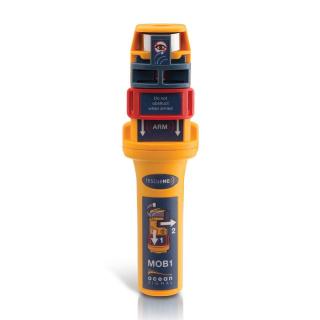MOB Beacons: Getting Better and Better
By Chuck Hawley, San Francisco, December 2018
We’re never satisfied.
As soon as someone comes out with a new product, or a new technology, it’s inevitable that in the next moment someone will say “yeah, but it would be neat if it could (insert some great idea here) in addition to what it does now.” When CCA member Stan Honey founded Etak in the mid-1983, these requests were called “can’t you justs”, as in “can’t you just make my Navigator show me the traffic on the roads?” It’s interesting to note that while his early car navigation systems were simple by today’s standards, virtually all of the “can’t you just” requests are now commonly found in free iPhone navigation apps.
So it is with marine electronics. One of the most exciting developments has been the progression of Man Overboard Beacons (or Crew Overboard Alarms or whatever you want to call them). Over the last 20 years or so, through about four generations of products and technology, these life-saving gizmos have evolved from being a bit iffy to being reliable and near-mandatory. Let’s briefly review the path that led to where we are now.
- 121.5 MHz transmitters: These small transmitters were very similar to small Class B EPIRBs. They transmitted at a few hundred milliwatts on the International distress frequency used by aviation and marine beacons, and required direction finding equipment on board the mother ship to allow the crew to backtrack to the person in the water (PIW). Range was limited, as is the case with zero-altitude VHF signals, and only a bearing to the person was offered; s/he could be yards or miles away as far as the RDF was concerned.
- Personal Locator Beacons: These came on the market around 2000, and were essentially miniaturized Category II EPIRBs with a smaller battery capacity and no ability to float or self-actuate. The good news is that the various constellations of SARSAT satellites could locate the PIW reasonably accurately; the bad news is that the mother ship had no such ability and had to rely to a great degree on the Coast Guard or other rescue agency for PIW recovery or locating.
- Cessation of Transmission Devices: These small transmitters check-in with a receiver on the mother ship. If the receiver doesn’t “hear” the transmitter on a periodic basis, it sounds an alarm and stores the current vessel position as the likely place to start a search. Immersion in water stops the crew-worn transmitters from transmitting, so the crewmember doesn’t have to do anything (other than fall into the wAIS or AIS/DSC Beacons: For the moment, these small GPS-equippeater) for the system to work. A limitation is that the only vessel that has an indication of the incident is the one with the receiver, although the navigator can alert other vessels in the area with a Pan Pan call.
- Man Overboard VHF transmitters (now generally called Personal AIS Beacons or PABs) are the last word in crew overboard detection and recovery. Not much larger than a big felt tip marker, or a pack of playing cards, these devices activate automatically, determine the PIW’s location, and transmit this information back to the mother ship and all other ships in the immediate vicinity. The position is updated frequently, so that as the current carries the poor soul in a different direction, his/her rescuers will know the most recent position.
To return to our original theme, there is always someone who wants to combine two or more technologies and end up with the ultimate Swiss Army Knife. What if you could alert the Coast Guard and alert the crew of the mother ship and receive a regularly updated position of the poor soul who fell, unceremoniously, in the drink? Soon, that will be possible, once the regulatory hurdles are overcome. Combined PLB-GPS-AIS transmitters have been rumored to be just around the corner, and now it appears that we’ll see the first models in 2019.
One of the barriers has been the extremely high standards to which EPIRBs and PLBs are built, and the mandate that, by combining functions together in a single product, none of their capabilities are reduced. Using the Swiss Army Knife analogy, it has to be a damned good knife as well as a perfect scissors and an ideal toothpick. No compromises.
Whether this will make a difference in marine safety remains to be seen. The current crew overboard alarms are pretty close to ideal, when installed correctly on life jackets and when the navigators know how to interpret their transmissions. Training, unsurprisingly, has not been rendered obsolete by technology.
The Cruising Club of America is a collection of passionate, seriously accomplished, ocean sailors making adventurous use of the seas. All members have extensive offshore boat handling, seamanship, and command experience honed over many years. “School of Hard Rocks” stories, published by the CCA Safety and Seamanship Committee, are intended to advance seamanship and help skippers promote a Culture of Safety aboard their vessels





